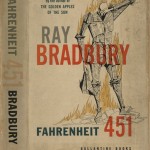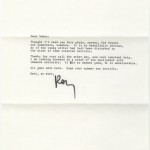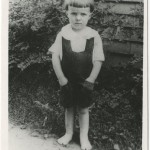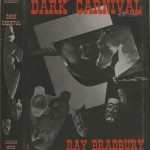Legendary science fiction writer Ray Bradbury, author of the classics Fahrenheit 451 and The Martian Chronicles, died last Wednesday at the age of 91. In his long writing career, Bradbury published hundreds of novels and short stories, becoming an icon in the world of literature that describes aliens, space ships, faraway planets—and the future of books.
Like the 13-year-old characters in his Something Wicked This Way Comes, Bradbury spent much of his boyhood visiting the public libraries of his Midwest hometown, where he was inspired by the works of such writes as Aldous Huxley, Jules Verne, and H. G. Wells. Throughout his life he was an enormous supporter of libraries, advocating them as some of the most important institutions in American life and culture. The son of an electrician father and a Swedish immigrant mother, Bradbury lacked the means for a formal college education and prided himself on being largely self-taught. In 1971, in aid of a fundraising effort for public libraries in southern California, he published the essay “How Instead of Being Educated in College, I Was Graduated From Libraries.” Like the characters in his most famous novel, Fahrenheit 451, Bradbury feared a future wherein books would become obsolete.
Bradbury faced an arduous challenge in making his own futuristic novels part of the libraries he so dearly loved. Early in his career, he had difficulty garnering interest for his science fiction stories from mainstream publishing houses. He was famously “discovered” by a young Truman Capote, then a staff member at Mademoiselle, who picked Bradbury’s 1947 short story “Homecoming” out of the slush pile of submissions to the magazine and encouraged its publication. The Alfred A. Knopf archive at the Harry Ransom Center, however, reveals that despite Capote’s early advocacy, Bradbury continued to meet with difficulties when seeking a home for his work. In a rejection letter from 1948, a reader at the publishing house professes hesitation toward Bradbury’s first novel, Dark Carnival. The evaluator states that though there is “much talk about town” of Bradbury’s “weird, unusual, and tricky” stories, “the style, while adequate, lacks distinction.”
Three decades later Bradbury, by then a seasoned author with dozens of publications to his credit, became a highly valued writer at the Knopf firm. During the 1970s he worked closely with editors Robert Gottlieb and Nancy Nicholas, who published his Where Robot Mice and Robot Men Run Round in Robot Towns, Dandelion Wine, and When Elephants Last in the Dooryard Bloomed, among others. In a letter to Nicholas (shown in the slideshow above), Bradbury, who often wrote nostalgically of childhood, included a picture of himself at the age of three. He jocularly describes the photograph as “beautifully serious, as if the young writer had just been disturbed in the midst of some creative activity.”
The Ransom Center also houses manuscripts and letters related to Ray Bradbury in its Lloyd W. Currey, Sanora Babb, Eliot Elisofon, Lillian Hellman, B. J. Simmons, and Tim O’Brien archives. Additionally, the Ransom Center’s Lewis Allen collection contains screenplay drafts, correspondence, casting notes, call sheets, and promotional materials for François Truffaut’s 1966 film adaptation of Fahrenheit 451.
Please click on the thumbnails below to view full-size images.








